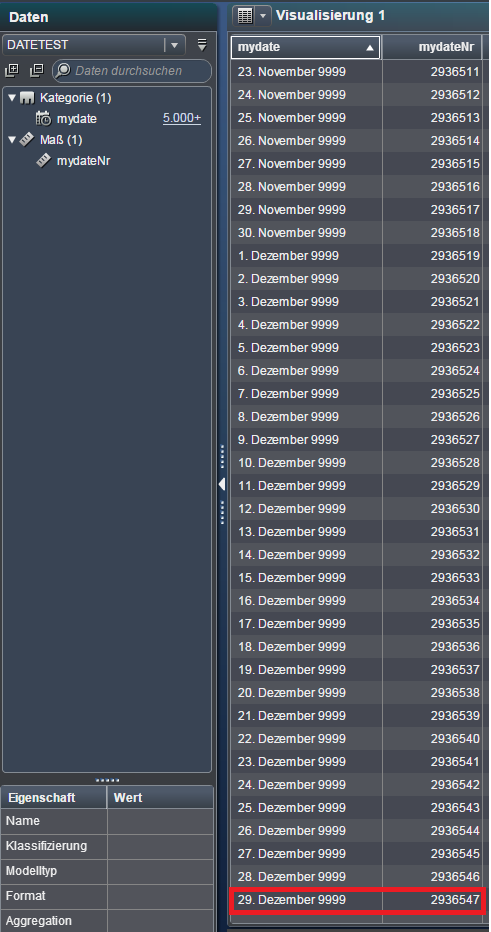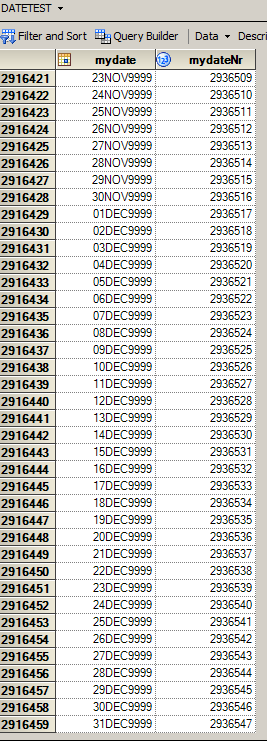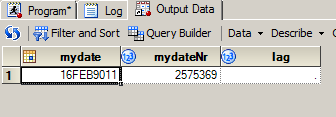- Home
- /
- SAS Viya
- /
- Visual Analytics
- /
- false "high-value" for a date in visual analytics 7.1
- RSS Feed
- Mark Topic as New
- Mark Topic as Read
- Float this Topic for Current User
- Bookmark
- Subscribe
- Mute
- Printer Friendly Page
- Mark as New
- Bookmark
- Subscribe
- Mute
- RSS Feed
- Permalink
- Report Inappropriate Content
hi,
we use the "31DEC9999" to identify the actual valid dataset.
Today we build a simple report with a drop-down list to filter the uploaded table on demand.
But the displayed high-value is the 29DEC9999. Because i am really sure that the table contains records with 31DEC9999, i opened SASStudio (same server) and searched for the 31DEC9999.... and there it is (screen2).
So maybe there is a bug or something really strange in our environment.
Perhaps someone can help and run this simple dataset and load the data into memory to check if it works correct.
thank you
marius
libname otto '/app/.....';
data otto.datetest;
format mydate date9.;
format mydateNr 8.;
do mydate="01JAN2015"d to "31DEC9999"d by 1;
mydateNr = mydate;
output;
end;
run;

proc sql;
select * from test.datetest where mydate="31DEC9999"d;
quit;

- Mark as New
- Bookmark
- Subscribe
- Mute
- RSS Feed
- Permalink
- Report Inappropriate Content
Hi,
Very strange screenshot indeed.
Took your code and run it with SAS Studio (University Edition)
and get for |mydate, mydateNr] = [31DEC9999, 2936547]
In SAS, a date is represented by the number of days from January 1rst, 1960.
It looks like in your environment, there is a shift of 2 days.
You could try this code:
data _null_;
d=0; put d= d= date9. d=yymmdds10.;
d=1; put d= d= date9. d=yymmdds10.;
d=2936545; put d= d= date9. d=yymmdds10.;
d=2936546; put d= d= date9. d=yymmdds10.;
d=2936547; put d= d= date9. d=yymmdds10.;
run;
On my desktop, log shows :
d=0 d=01JAN1960 d=1960/01/01
d=1 d=02JAN1960 d=1960/01/02
d=2936545 d=29DEC9999 d=9999/12/29
d=2936546 d=30DEC9999 d=9999/12/30
d=2936547 d=31DEC9999 d=9999/12/31
HTH
- Mark as New
- Bookmark
- Subscribe
- Mute
- RSS Feed
- Permalink
- Report Inappropriate Content
Hi,
yes that`s really strange.
I guess there is a bug in va, when someone wants to display a high date like 31DEC9999.
Because the 0 = 01JAN1960 works and other values <9999 too.
Perhaps someone can help and run the dataset and load the data into memory to check if this is a global issue.
thank you
marius
- Mark as New
- Bookmark
- Subscribe
- Mute
- RSS Feed
- Permalink
- Report Inappropriate Content
Hi Marius,
I was curious to see this myself and did the following testing.
1) I ran your code in SAS Enterprise Guide and got the dates as you did.

2) I loaded the data into SAS Visual Analytics 6.4 and the date value for 31DEC9999 is the same as you experienced. Perhaps this is due to leap years over time and for some reason this is calculated differently in SAS VA. Why? :smileyconfused:

3) I was curious to know at what point is the difference between the dates less than one so I exported the data from SAS Visual Analytics and imported it into SAS Enterprise Guide and calculated the lag to see where it was less than 1 and found the following...
data test;
set work.export;
if lag<1;
format mydate date9.;
run;
And the result table, test contains the value:

Interesting observation ! As the date 31DEC9999 is traditionally used to indicate a valid/open transaction when working with slowly changing dimension data, it is crucial to ensure the SAS date 31DEC9999 is the same number as when used on the SAS Workspace Server. I agree there seems to be an issue with large dates in SAS Visual Analytics. Please report your findings to SAS Technical Support.
Kind Regards,
Michelle
- Mark as New
- Bookmark
- Subscribe
- Mute
- RSS Feed
- Permalink
- Report Inappropriate Content
What could be?
- There is some statement they have build something new for SAS-VA not using all the old code.
- Whithin JAVA there as whole approach on dates. DateFormat (Java Platform SE 6) (format and calculations on the epoch)
These are possible different to JAVA version and machines.
Gettting the bad feeling there is some difference introduced only getting into that problems using those high 9999 years leap-year or whatever
Definitely something to bother TS for.
April 27 – 30 | Gaylord Texan | Grapevine, Texas
Registration is open
Walk in ready to learn. Walk out ready to deliver. This is the data and AI conference you can't afford to miss.
Register now and lock in 2025 pricing—just $495!
See how to use one filter for multiple data sources by mapping your data from SAS’ Alexandria McCall.
Find more tutorials on the SAS Users YouTube channel.




